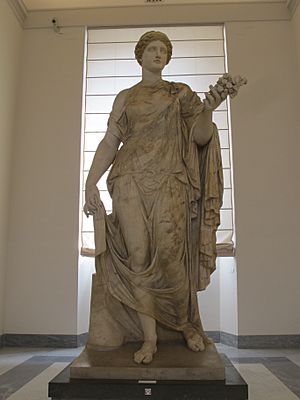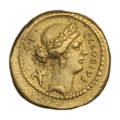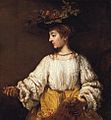Flora (mythology) facts for kids
Flora is the goddess of flowers and spring in Roman mythology. She is like a guardian of all blooming plants, especially those that provide food. Her name comes from the Latin word flos, which means "flower."
Contents
Who is Flora?
Flora is a very old goddess in Ancient Rome. She was worshipped even before the city of Rome was founded. She represents the beauty and new life that spring brings. People believed she made flowers bloom and helped crops grow. She was often shown as a beautiful young woman crowned with flowers, holding a cornucopia (a horn of plenty) filled with blossoms.
Flora's Family and Friends
In some stories, Flora was married to Zephyrus, the god of the west wind. Zephyrus was known for bringing gentle breezes that helped flowers grow. Together, they brought life and color to the world. Flora was also sometimes linked to Chloris, a Greek goddess of flowers, showing how Roman and Greek myths often shared ideas.
The Festival of Floralia
The most important event for Flora was a festival called the Floralia. This festival was held every year from April 28th to May 3rd. It was a time of great celebration and joy.
How Floralia Was Celebrated
During the Floralia, people would wear colorful clothes and decorate themselves with flowers. They would throw flowers into the streets and hold special games and performances. There were also theatrical shows and races. The festival was meant to ask Flora to bless the spring crops and ensure a good harvest. It was a very lively and fun event, quite different from some of the more serious Roman festivals.
Floralia's Importance
The Floralia was important because it celebrated the start of the growing season. Farmers especially looked forward to it, hoping for good weather and healthy plants. It reminded everyone of the power of nature and the beauty of new beginnings.
Flora in Art and Culture
Flora has inspired many artists throughout history. She is often seen in paintings, sculptures, and even poems.
Famous Artworks Featuring Flora
Many famous artists have painted Flora. For example, the Renaissance painter Sandro Botticelli included her in his famous painting Primavera. In this artwork, Flora is shown scattering flowers, representing the arrival of spring. Later artists like Rembrandt also painted her, often showing her with a gentle and thoughtful expression, surrounded by blossoms. These artworks help us imagine what Flora might have looked like and how important she was to people.
Flora's Legacy Today
Even today, Flora's name is used in many ways. The word "flora" refers to all the plant life in a particular region or time. For example, you might talk about the "flora of a rainforest." Her name also appears in many gardens, flower shops, and even names of people. This shows how her ancient role as the goddess of flowers continues to influence our language and culture.
Images for kids
-
Flora on a gold aureus of 43–39 BCE
-
Detail of Flora from Primavera by Botticelli, c. 1482
-
Flora and Zephyr, by Jan Brueghel the Elder and Peter Paul Rubens, 1617
-
Flora by Rembrandt, 1654
See also
 In Spanish: Flora (mitología) para niños
In Spanish: Flora (mitología) para niños








